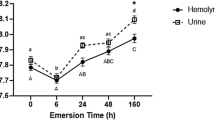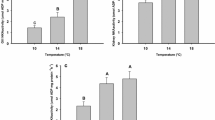Summary
Dusky-footed woodrats (Neotoma fuscipes) and desert woodrats (N. lepida) experience pronounced seasonal variations in the aridity of their habitats. The effects of seasonal aridity upon the water conserving abilities of these species were assessed through measurements of water conserving abilities and kidney structure of animals captured in summer and winter, and through measurements of animals' abilities to acclimate to differing water availabilities in the laboratory.
Urine concentrating ability was the water conserving mechanism most responsive to changes in the availability of water. Summer and summeracclimated N. fuscipes (431.7 and 459.4 mEqCl-/1) demonstrated urine Cl- concentrating abilities substantially greater than those of winter and winter-acclimated N. fuscipes (245.7 and 337.4 mEqCl-/1). Summer, winter-acclimated, and winter N. lepida exhibited urine Cl- concentrations equivalent to those of winter N. fuscipes; summer-acclimated N. lepida exhibited markedly greater values (466.7 mEqCl-/l) equivalent to those of summer and summer-acclimated N. fuscipes.
Measurements of relative thicknesses of renal cortex and medulla yielded no significant differences among the experimental groups of N. fuscipes and N. lepida, thus suggesting that both species possess equal abilities to concentrate urine. These data are confirmed by urine concentrations of summer-acclimated animals of both species.
Water conserving abilities of both species correlate well with climatic and dietary plant water content data. Thus, during the dry, warm summer months (when plant moisture is reduced) N. fuscipes conserves water mainly through increased urine concentration. The laboratory acclimation data and differences between summer and winter animals strongly suggest that N. fuscipes undergoes an acclimatization to the seasonal aridity which increases gradually during spring and peaks in late summer, thus enabling this water-dependent species to exist on reduced water requirements. The uniformly low water conserving abilities of winter-acclimated, winter, and summer N. lepida physiologically verify the previous reports that this species satisfies its water requirements through utilization of succulent cactus, thereby avoiding the stress of summer aridity in its habitat.
The fact that both species exhibit equal capacities to conserve water indicates that the much greater geographic distribution of N. lepida is not the result of differences in physiological water conserving abilities, but instead may be the result of specific physiological adaptation by N. lepida to utilization of cactus and other plants containing noxious or toxic compounds.
Similar content being viewed by others
References
Bartholomew, G.A., Hudson, J.W.: Effects of sodium chloride on weight and drinking in the antelope ground squirrel. J. Mammal. 40 354–360 (1959)
Blount, R.F., Blount I.H.: Adaptive changes in size of renal papilla with altered function. Texas Rep. Biol. Med. 26, 473–484 (1968)
Bradford, D.F.: Water stress of free-living Peromyscus truei. Ecology 55, 1407–1414 (1974)
Carpenter R.E.: A comparison of thermoregulation and water metabolism in the kangaroo rats Dipodomys agilis and Dipodomys merriami. Univ. Calif. Publ. Zool. 78, 1–36 (1966)
Carpenter, R.E.: Salt and water metabolism in the marine fish-eating bat, Myotis (Pizonyx) vivesi. Comp. Biochem. Physiol. 24, 951–964 (1968)
Church, R.L.: Evaporative water loss and gross effects of water privation in the kangaroo rat, Dipodomys venustus. J. Mammal. 50, 514–523 (1969)
Coulombe, H.N.: Physiological and physical aspects of temperature regulation in the burrowing owl, Speotyto cunicularia. Comp. Biochem. Physiol. 35, 307–337 (1970)
Gettinger, R.D.: Metabolism and thermoregulation of a fossorial rodent, the northern pocket gopher (Thomomys talpoides). Physiol. Zool. 48, 311–322 (1975)
Haines, H., Ciskowski, C., Harms, V.: Acclimation to chronic water restriction in the wild house mouse Mus musculus. Physiol. Zool. 46, 110–128 (1973)
Haines, H., Schmidt-Nielsen, K.: Water deprivation in wild house mice. Physiol. Zool. 40, 424–431 (1967).
Haines, H., Shields C.F. III, Twitchell,C.: Reduced evaporation from rodents during prolonged water restriction. Life Sciences 8, 1063–1068 (1969)
Hall, E.R., Kelson, K.R.: The mammals of North America. New York: The Ronald Press 1959
Heisinger, J.F. Breitenbach R.P.: Renal structural characteristics as indexes of renal adaptation for water conservation in the genus Sylvilagus. Physiol. Zool. 42, 160–172 (1969)
Hudson, J.W., Rummel, J.A.: Water metabolism and temperature regulation of the primitive heteromyids, Liomys salvani and Liomys irroratus. Ecology 47, 345–354 (1966)
Lasiewski, R.C., Acosta, A.L., Bernstein, M.H.: Evaporative water loss in birds. I. Characteristics of the open flow method of determination and their relation to estimates of thermoregulatory ability. Comp. Biochem. Physiol. 19, 445–457 (1966)
Lee, A.K.: The adaptations to arid environments in woodrats of the genus Neotoma. Univ. Calif. Publ. Zool. 64, 57–96 (1963)
Lee, A.K., Brown, J.H.: Variations in the hemoglobin concentrations of Great Basin rodents. J. Mammal. 51, 669–674 (1970)
MacMillen, R.E.: Population ecology, water relations, and social behavior of a Southern California semidesert rodent fauna. Univ. Calif. Publ. Zool. 71, 1–59 (1964)
MacMillen, R.E.: Aestivation in the cactus mouse, Peromyscus eremicus. Comp. Biochem. Physiol. 16, 227–248 (1965)
MacMillen, R.E.: Water economy of nocturnal desert rodents. In: Symp. Zool. Soc. London, Vol. 31. Comparative physiology of desert animals. (G.M.O. Malloiy, ed.), pp. 147–174. New York: Academic Press 1972
MacMillen, R.E., Christopher, E.A.: The water relations of two populations of noncaptive desert rodents. In: Environmental physiology of desert organisms (N.F. Hadley, ed.), pp. 117–137. Stroudsberg: Dowden, Hutchinson, and Ross 1975
MacMillen, R.E., Grubbs, D.E.: Water metabolism in rodents. In: Progress in animal biometerology, Vol. 1, Part I (D.H. Johnson, ed.), pp. 63–69. Lisse, The Netherlands: Swetz and Zeitlinger 1976
MacMillen, R.E., Lee, A.K.: Australian desert mice: independence of exogenous water. Science 158, 383–385 (1967)
MacMillen, R.E., Lee, A.K.: Water metabolism of Australian hopping mice. Comp. Biochem. Physiol. 28, 493–514 (1969)
Meserve, P.L.: Ecological relationships of two sympatric woodrats in a California coastal sage scrub community. J. Mammal. 55, 442–447 (1974)
Munz, P.A., Keck, D.D.: A California flora. Berkeley: Univ. Calif. Press 1970
Schmidt-Nielsen, B., Schmidt-Nielsen, K., Brokaw, A., Schneiderman, H.: Water conservation in desert rodents. J. Cell. Comp. Physiol. 32, 331–360 (1948)
Schmidt-Nielsen, K.: How animals work. New York: Cambridge University Press 1972
Schmidt-Nielsen, K., Schmidt-Nielsen, B.: Water metabolism of desert rodents. Physiol. Rev. 32, 135–166 (1952)
Sperber, I.: Studies on the mammalian kidney. Zool. Bidr. Fran Upps. 22, 249–431 (1944)
Steele, R.G.D., Torrie, J.H.: Principles and procedures of statistics. New York: McGraw-Hill 1960
Tucker, V.A.: Oxygen consumption, thermal conductance, and torpor in the California pocket mouse Perognathus californicus. J. Cell. Comp. Physiol. 65 393–404 (1965)
U.S. Department of Commerce, National Oceanic and Atmospheric Administration, National Weather Service. Local climatological data for Escondido, California. Washington, D.C.: U.S. Government Printing Office 1963–1973
Willems, N.J., Armitage, K.B.: Thermoregulation and water requirements in semiarid and montane populations of the least chipmunk, Eutamias minimus. II Water balance. Comp. Biochem. Physiol. 52, 109–120 (1975)
Wolf, A.V.: Thirst: physiology of the urge to drink and problems of water lack. Springfield: Thomas 1958
Wunder, B.A.: Temperature regulation and the effects of water restriction on Merriam's chipmunk, Eutamias merriami. Comp. Biochem. Physiol. 33, 385–403 (1970)
Author information
Authors and Affiliations
Rights and permissions
About this article
Cite this article
Stallone, J.N. Seasonal changes in the water metabolism of woodrats. Oecologia 38, 203–216 (1979). https://doi.org/10.1007/BF00346564
Received:
Issue Date:
DOI: https://doi.org/10.1007/BF00346564




